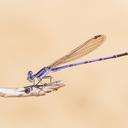United States and Canada
The head of the male is violet with a black line that runs through the ocelli and between the compound eyes. This line is sometimes interrupted at its middle. There are also large violet postocular spots. The middorsal stripe is black on violet pterothorax and the violet antehumeral stripe is nearly as wide as the middorsal stripe. The black humeral stripe is only 1/3 or less as wide as these stripes and is generally forked the upper 1/2 to 1/3 of its length. The pterothorax is pale laterally and ventrally. The legs are pale with black stripes on the outer surfaces of the femora which are divided for their entire length by a pale stripe. The outer surfaces of the tibiae are entirely bl ack. There are 4 and 3 postquadrangular cells in the fore- and hindwings, respectively. The abdomen is largely violet on segments 1-7, with a pale yellow venter. There is a dark black dorsal spot basally on segment 1. Segment 2 has a black lateral stripe which may be interrupted at its middle, forming two spots. There is a dark narrow ring apically on segments 2-7 and an apical black spot confluent with this ring on segments 3-6. Segment 7 is black except for a pale basal ring. Segments 8-10 are blue with a small ventrolateral black spot apically on 8. The paraprocts are forked and longer than the cerci which are concave ventrally with an outwardly directed tooth on the inner edge and a ventrally directed subapical black tubercle. The head and thorax of the female is similar to the male, but with the pale areas largely brown instead of violet. The mesostigmal plates are distinctive with a narrow posteriorly directed lobe recurved medially. Mesepisternal tubercles are absent. The abdomi nal pattern is similar to that of the male with segments 2-6 bearing a narrow apical black ring and dark lateral stripe that extends the full-length of each segment, widening apically. The widened areas may become confluent dorsally on the posterior segments. Segments 2-7 also have a dark oblique stripe ventrolaterally. This stripe sometimes becomes confluent with the dorsolateral stripe. Segment 7 is black dorsally with only a pale thin middorsal line and basal ring. Segments 8 and 9 bear a dorsolateral stripe that nearly reaches the apex of each segment.
Size: Total length: 30-35 mm; abdomen: 24-28 mm; hindwing: 17-21 mm.
Similar Species (south-central US): Gloyd (1958) discussed the similarities and differences of Lavender Dancer and Variable Dancer (A. fumipennis), which may be difficult to tell apart where they are found together. She described Lavender Dancer as a more slender species, with a more "delicate and orchid-like" purple color. Lavender Dancer lacks a complete ventrolateral dark strip on segments 8 and 9 as seen in Variable Dancer. Leonorae's Dancer (A. leonorae) has distinctive black arrow or spear-shaped markings dorsally on the abdomen. Aztec Dancer (A. nahuana) lacks dark markings anterolaterally on segments 4 and 5.
Habitat: Semidesert creeks, streams and rivers.
Natural History: Lavender Dancer is found in the western desert areas of our region where it is relatively uncommon and remains unknown biologically.
Distribution: Southwestern U.S.; California east to Texas and south through Mexico.
Source: Abbott, J.C. 2006-2010. OdonataCentral: An online resource for the distribution and identification of Odonata. Available at OdonataCentral.
Edited by Drew Weber (9/24/2015).
